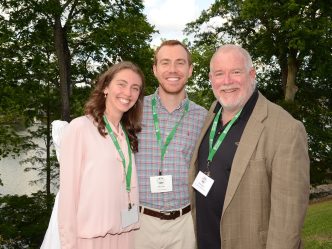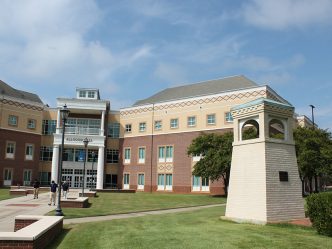In a society where change happens in the blink of an eye, leaders who can understand problems, advocate for their solutions and incorporate real-world innovation into their respective fields are an absolute necessity.
That’s the philosophy behind the College of Education’s first doctoral degree offering—the Educational Innovation Ed.D. program.
Designed to prepare scholarly practitioners to respond to evolving educational systems, the 55-hour program can be completed in as little as three years and focuses on finding solutions to real-world problems, both within and outside the field of education.
Of the program’s current participants, Dr. Zach Kelehear, dean of the College of Education at Augusta University points out, 10 work in K-12 educational environments and two work in “middle-to-upper-tier leadership” in colleges and units. Though they vary in race, age, gender and occupation, all of the program’s participants are seeking answers to the same question: What does it mean to lead real, concrete change while still honoring the works of the past?
The program’s curriculum seeks an answer to that question. Or rather, it seeks to help participants answer it for themselves.
“The curriculum represents, for me, a roadmap,” Kelehear said. “It helps the group navigate change, understand it and look for the mile markers of a successful innovation.”
That, Kelehear said, is how the program approaches its curriculum, both from a practical and a theoretical standpoint. But there’s something more the program looks for, something Kelehear believes has the power to drive change more effectively than any lesson or guideline ever could.
“I don’t interview the participants directly, because that’s a program decision, and I try to stay out of the way of good work,” he said. “But I do like to ask our applicants afterward, ‘What motivates you to think you can lead change?”
The answer he’s looking for, Kelehear said, isn’t a talking point or a previously formulated response. Put simply, the things he’s looking for are the bravery to lead—the ability of participants to state, unashamedly, that they have ideas and that they believe those ideas will work—and the skills needed to find real-world solutions.
“It’s a lovely conversation,” he said. “It’s a little tongue-in-cheek, but we want people to come to us who are both confident and competent, because they have not only the skills to initiate change, but also because they have the audacity to consider alternatives.”
The leadership tactics participants learn doesn’t pertain strictly to educational outcomes, however.
Kelehear stresses that the right student could find benefit in this program regardless of his or her occupation.
“If we do this thing the way we’ve dreamed of doing it, it would include people in educational settings, universities, technical schools, but it would also include people from outside organizations,” he said. “We discuss curriculum and the ways curriculum creates roadmaps for learning, but we also discuss budgetary and grant work as well as means of fostering innovative thinking.”
The beauty of a more inclusive approach to problem solving, Kelehear said, is that the need for creative, innovative leaders can be placed almost anywhere.
“Think at the university level,” he said. “We could cultivate some of our own leaders to guide individuals through change initiatives and the complexities of dealing with new problems. You could have people all the way up to the assistant dean level, for example, who maybe have aspirations of being in higher leadership positions at the dean, provost or presidential level someday.”
Step a layer out, Kelehear explained, and in cities like Augusta and Atlanta, participants might include city government officials or local businesses who handle professional or human resources development.
“These people wonder, well, how do we manage our employees and help them to grow and develop over time?” he said. “How do we help our employees become more creative, innovative problem solvers?”
There’s even a place for leadership education in the arts sector.
“We have a strong arts community in the area, and if you think of people who are managing studios or museums, they’re people who need to understand how to solicit and secure grants,” Kelehear explained.
Ultimately, though, no matter what position one holds in an organization, an Ed.D. explains that its holder is well-versed in solving problems and leading change.
“What an EdD says at the end of the day is that this person can identify a problem, develop a map and some data points to inform his or her journey along that map and bring a problem to a successful conclusion,” Kelehear said. “Independently, responsibly and respectfully.”
For some, the increased freedom is problematic. According to Kelehear, some members of the original cohort entered the program expecting a more “well-regimented, task-oriented check off” system.” By contrast, the more ambiguous, collaborative program they found themselves in has proven something of a challenge.
In Capstone and Dissertation Practice, students are placed together in groups of two or three, but may also be expected to work with up to five other colleagues.
Increasingly, the modern workforce is demanding creative, teamwork-oriented problem solvers to meet modern challenges. As such, working together is a staple of the Educational Innovation Ed.D.
“Our program is rooted firmly in the assumption that working together, sharing diverse perspectives and considering how we as a group can offer multiple solutions to common problems is the best way to approach change,” Kelehear said. “I want us to be known as an innovative and creative College of Education, and my evaluation of my faculty revolves partially around their ability to be innovative and creative.”
Kelehear said that, in both the program and in his faculty evaluations, he wants to invite creativity. More importantly, though, he hopes to invite joy.
“I just roam in and out of classes, and I know my faculty must be tired of that,” Kelehear joked. “What I’m really looking at is the joy of their teaching. If my faculty show that, that they have a joy in teaching, then we’ve created the right space, because students will see that and will adopt the approach as well.”
That point, central to Kelehear’s leadership and educational philosophy, translates fully into the Ed.D. program.
“What lights your light? What sings your song? That’s what I want my faculty and the students who spend time with them to see as a theme throughout the College of Education,” he said. “If our Ed.D. produces people who have a habit of being open and willing to risk innovative ideas to solve a problem, then I’d say we’ve done pretty well.”
 Augusta University
Augusta University




